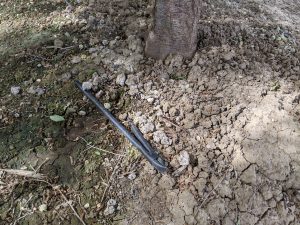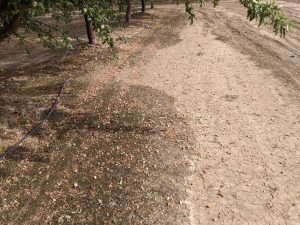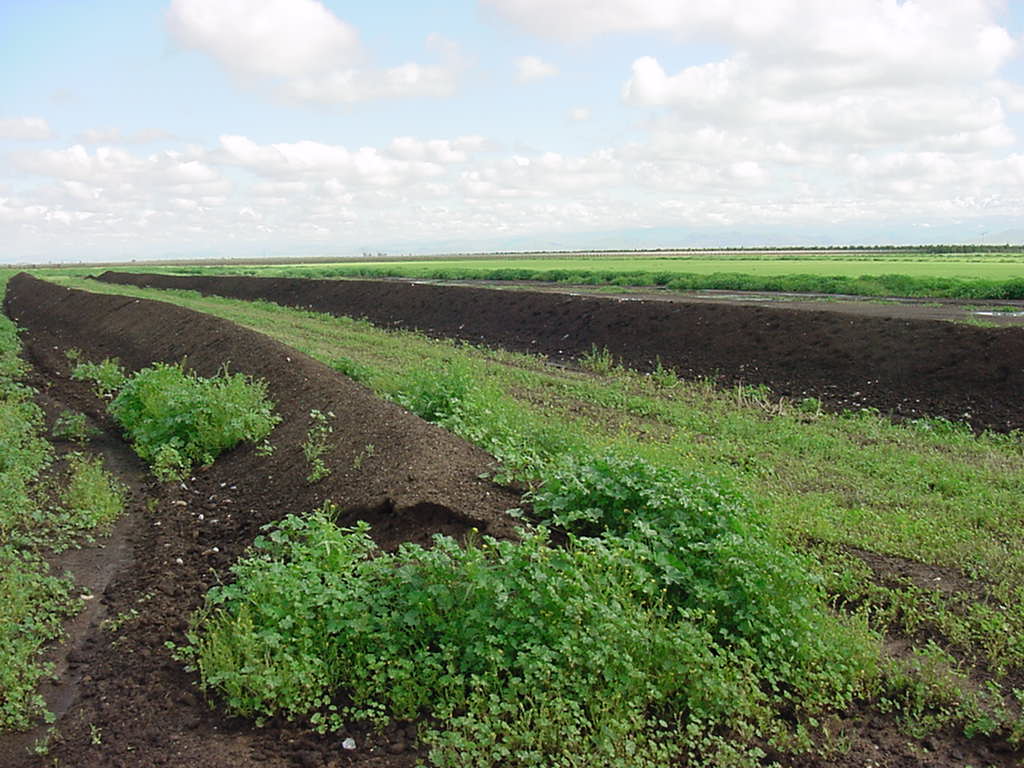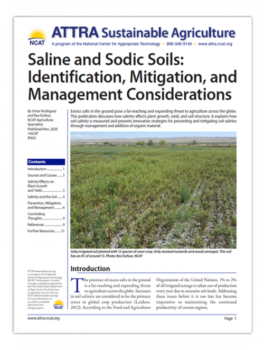Saline and Sodic Soils: Identification, Mitigation, and Management Considerations
By Omar Rodriguez and Rex Dufour, NCAT Sustainable Agriculture Specialists
Abstract
Excess salts in the ground pose a far-reaching and expanding threat to agriculture across the globe. This publication discusses how salinity affects plant growth, yield, and soil structure. It explains how soil salinity is measured and presents innovative strategies for preventing and mitigating soil salinity through management and addition of organic material.
Test Results: Looking at EC and SAR
Three factors that are typically examined in order to determine a soils classification in terms of salinity are Electrical Conductivity (EC), Sodium Absorption Ratio (SAR), and pH (potential hydrogen).
Electrical Conductivity (EC), sometimes referred to as specific conductance, measures the ease with which current can pass through an object; in this case, the object is the soil (ECe) or irrigation water (ECw). The more salt in a sample, the more easily a current will pass through that sample. Lab test results will provide measurements in the form of millimhos per cm (mmhos/cm) or decisiemens per meter (dS/m). These units are equivalent to one another: 1 mmoh/cm = 1 dS/m.
Sodic soils are distinguished by having higher concentrations of sodium (Na+) relative to calcium (Ca2+) and magnesium (Mg2+). The most reliable test for sodicity of soil or water is the sodium absorption ratio (SAR), which compares the concentration of sodium to calcium and magnesium. An alternate test that is also used to determine sodicity is the exchangeable sodium percentage (ESP). This test compares the amount of sodium relative to the cation exchange capacity (CEC) of the soil sample. CEC is a term that describes the ability of a soil particle (negatively charged) to bind to positively charged molecules or elements like salt (Hazelton and Murphy, 2016). When sodium binds to a soil particle, it can only form one connection. The resulting particle then repels neighboring particles, leading to soil that is dispersed, with poor structure and limited water-holding capacity.
Testing Soil for Salinity
When conducting tests for salinity, it is valuable to take multiple samples at varying depths in order to measure two important factors: 1) a benchmark for each of the soil layers measured (take note of the relative distribution of salts at each layer); and 2) the degree to which salts are being flushed deeper into the soil profile over time, as management and prevention measures are being implemented. A good starting point is to sample to a depth of two feet in increments of six inches. Testing in this manner will allow the farmer to make note of whether salts present in the soil profile are working their way deeper and out of reach of plant roots. The grower should request the soil lab’s analysis and recommendations for addressing the soil’s salt/sodium issues. And these recommendations should be, well, taken with a grain of salt. If possible, get a second opinion.
| Salinity Class | EC (electrical conductivity) dS m-1 or mmhos cm-1 |
|---|---|
| Nonsaline | 0-2 |
| Very slightly saline | 2-4 |
| Slightly saline | 4-8 |
| Moderately saline | 8-16 |
| Strongly saline | >16 |
Water Testing for Salinity
Testing irrigation water is just as important as testing the soil. In farm settings, irrigation water and shallow saline water tables are the primary means through which water-soluble salts make it to the soil surface (Maas and Grattan, 1999). It is useful to note the relative impact the water may have on the soil, based on its concentration of salts. Table 4 can be used to estimate the potential impacts that irrigation water will have on plants, as well as its potential to deposit excess salts.
| Quality of Irrigation Water | EC dS/m mmhos/cm | SAR | Risk of Sodicity from Irrigation Water |
|---|---|---|---|
| Excellent | 0 – 0.80 | 1 – 10 | Low |
| Good | 0.80 – 2.5 | 10 – 18 | Moderate |
| Saline* | 2.5 – 5 | 18 – 26 | High |
| Very salty* | >5 | >26 | Very high |
| * Leaching may be necessary, and good management practices that promote soil health are recommended. | |||
Considerations for Testing Water
Due to the natural ebb and flow of salt concentrations with the seasons, irrigation water and soil tests will tend to correlate with higher concentrations during dry periods and lower concentrations during the rainy season. Take note of salt loads throughout the year.
- If you suspect or know that your farm is affected by salts, it may be beneficial to invest in an EC meter. Depending on the model, you will be able to test the soil, water, or both.
- Where is the sample taken? Irrigation radius (drip, sprinkler, micros) or between tree rows; bed or furrow; elevation within field (lower points tend to accumulate more salts).
- In general, a SAR test isn’t a part of standard soil-testing parameters and needs to be ordered separately.
Prevention, Mitigation, and Management
Remediating Saline Soils
Aside from a few very expensive management options, flushing salts further down into the soil profile with clean (low-salt) water is the only way to directly lower salt concentrations in managed soils. Limiting the use of inputs that have high concentrations of salt, such as saline irrigation water, chemical fertilizers, or dairy manure, will serve as a good first step in reducing salt loads. Because good drainage is important to the leaching of salts, employing soil-management practices that improve soil structure and hydraulic flow through your farm’s soil will aid in moving salts away from sensitive crop-growing areas.
Remediating Sodic and Saline-Sodic Soils
Due to low permeability, soils classified as saline-sodic or sodic require an additional step in order to effectively flush salts down into the soil profile, while maintaining or improving soil function. Some form of calcium, usually gypsum, is used to replace excess sodium present in the soil. Due to its stronger charge, calcium can replace the sodium attached to soil particles. Freed sodium then converts to salt in the form of Na2SO4, which is more easily leached from the soil. Some organic amendments have been shown to be excellent options when remediating alkaline soils (sodic soils tend to be alkaline).
Whether biochar, biosolids compost, or green waste compost is applied, each will reduce EC, ESP, and SAR to varying degrees, and when combined with gypsum, will reduce salinity to a greater degree than gypsum or organic components alone (Chaganti et al., 2015).
Management Practices for Soil Remediation
Particular management practices and related factors can increase the likelihood that salts will deposit on the soil surface. Poor management of irrigation water and excess tillage can exacerbate salinity problems. Excessive tillage, for example, can create a hardpan under the soil surface. This is a layer through which water percolates very slowly or not at all. Also, saline water sitting just below the soil surface can rise to the surface through capillary action. Capillary action describes the ability of water to move through narrow spaces regardless of external forces, including gravity. If you have ever left a paper towel to soak up water and watched the water spread across its fibers, you were observing capillary action. This is the same process that occurs in the soil when water is able to migrate upward through the soil profile. In this case, the water, with its load of salt, migrates to the surface, and the water evaporates continually, leaving ever-increasing amounts of salt behind.
The above-listed remediation techniques will do little to improve soil salinity conditions when hardpan layers or excessive soil compaction are present on the farm. In these situations, it may be advisable to break up impermeable layers mechanically (“ripping” the soil with deep ploughing or subsoiler), followed by a reduction in soil management practices that create these adverse conditions (Abrol et al., 1988). The reduction in salinity-enhancing management practices must be accompanied by implementation of practices that can help mitigate saline conditions, described in detail below.
Mitigating Saline Conditions: Addition of Organic Material
Adding organic amendments is a viable method of addressing the negative impacts of salinity in the soil. Saline soils have been shown to benefit from compost, manure, green wastes, and other organic amendments, which reduce the impact of erosive forces and improve soil structure and soil function (Diacono and Montemurro, 2015). Additionally, organic matter aids in jump-starting biological and chemical processes, which can buffer the negative effects imposed by salt and help to increase nutrient cycling and availability (Rao and Pathak, 1996).
Adding organic matter helps maintain the soil ecosystem, which can improve soil physical properties through the stabilization of aggregates. Bacteria and fungi release various glue-like substances through their metabolic processes that contribute to the adhesion of soil particles, creating soil aggregates. Increases in organic matter in soils impacted by excess salts have been shown to increase soil porosity and aeration (organic matter has much the same effect in non-saline soils), resulting in greater infiltration rates and reduction in soil salt content when flushed with water that is low in soluble salts (Diacono and Montemurro, 2015).
In other experiments, under saline conditions, the addition of poultry manure and compost has been shown to increase available potassium. The addition of soluble and exchangeable potassium (K+) acts in a similar capacity to calcium and magnesium; that is to say, under sodic conditions, potassium will compete with sodium for space on the soil particles. What’s more, K+ plays an important role in the physiological function of plants, which can buffer some of the detrimental effects of salt stress (Diacono and Montemurro, 2015).
Considerations: Manure and Composted Manure
Avoid adding raw or composted manure to fields with crops that are highly sensitive to salt—especially dairy manure, which is typically higher in salt content (Lloyd et al., 2016). In well composted or aged manure, salt loads will be much lower than in fresh manure, and it may be added on a case-by-case basis. Testing of these amendments for salt content is recommended prior to application.Composted dairy manure has some benefits to soils, but soils should be monitored for salinity if there are repeated applications of this type of compost. Photo: Rex Dufour, NCAT
Mitigating Saline Conditions: Mulching
Mulches effectively limit the amount of salt accumulation on the soil surface because they reduce evaporation from the soil surface by 50% to 80%. Mulches can take various forms and can be used in a number of ways. Plastic cover and organic mulches are both effective options. Although both plastic and organic mulches are viable options for the reduction of salt accumulation, there are associated costs and benefits to both.
Plastic mulches may require lower management and labor cost than organic mulches, but they are less effective than organic mulches when it comes to reducing salt accumulation (on average, 32% less salt accumulation on organic mulches) (Aragues et al., 2014). Plastic mulches can intercept precipitation, which reduces any potential leaching effect from rainfall. Plastic mulches also deteriorate over time and require disposal (Aragues et al., 2014). Organic mulches, on the other hand, may decompose rapidly and need to be replaced more often. They also benefit the soil ecosystem by feeding it and promoting earthworm populations (Jodaugiene et al., 2010).
Considerations for Hoophouses
Soil under hoophouses will accumulate salts because rainfall cannot reach the soil surface. Growers should keep this in mind when planning hoophouse construction. There are two design options that can help to address this issue: having the hoophouse on skids or wheels so it can be moved if it appears that salts are accumulating, or designing the hoophouse so that the plastic tarp can be moved to allow rainfall through.

Bare soil, exposed to both the sun and wind, loses moisture more rapidly than mulched soil. Water evaporates, leaving a crust of salts behind. Photo: Rex Dufour, NCAT

The border between moist soil and the dry soil, which is beginning to accumulate salts. Notice the light-colored streak. Photo: Rex Dufour, NCAT
Promoting Plant Growth and Soil Remediation with Microbes
Certain naturally occurring microbial species have been shown to improve plant growth and remediate soils under salt-stress conditions (Kumar et al., 2019; Wang et al., 2020). Interesting research is being done to uncover the mechanisms at work and to identify the particular physiological effects that these microorganisms have on plants and the soil ecosystem. For example, when Trichoderma harzianum is used as a seed treatment, it has been shown to mitigate some of the stresses imposed on germinating seeds by excessive salt loads. Treated samples showed increased root and shoot growth, photosynthetic rate, and leaf area when compared to control samples (Rawat et al., 2012).
Arbuscular mycorrhizal fungi (AMF) represent a large group of symbiotic fungi that form relationships with more than 80% of all terrestrial plants (Kumar et al., 2019). AMF have proven to be effective soil remediators and plant growth promotors that can be purchased commercially or mobilized naturally in the soil through the planting of symbiotic plant species (Nurbaity, 2014). Moreover, the relative abundance of these naturally occurring beneficial microbial populations (bacteria included) can be further facilitated through planting salt-tolerant crops and/or cover crops that can greatly influence the development and function of microbial communities in salt-affected soils (Wang et al., 2020). In saline soils, AMF help plants by improving water absorption, nutrient uptake, increased photosynthesis and adaptation to oxidative stresses (Kumar et al., 2019).
Short-Run Strategies that Can Be Implemented Now
Drainage: Strategic placement and use of drainage ditches located in-field and on property borders can help to alleviate salt-related stresses placed on particular areas of a field or property.
Drought-resistant crops and salt-resistant crops: Drought-resistant crops can help to diminish some of the irrigation requirements. Irrigation reduction is most useful during the dry season, when the likelihood of irrigation with saline water increases. Switching to more salt-tolerant crops can be a short-term solution to production woes caused by excess salts.
Grafting: Grafting can be used to increase plant resistance to salts, when salt-tolerant rootstocks are available.
Concluding Thoughts
American agriculture is facing increasing challenges and experiencing severe climate events more often now than in the past. Farmers are having to deal with unprecedented droughts, flooding, and fires, as well as more erratic and extreme precipitation and temperatures. If we are to avoid the fates of the civilizations Marc Reisner noted in the introduction—Assyria, Carthage, Mesopotamia, the Inca, the Aztec, the Hohokam—we, as a society, must pay more attention to better managing our soils as the complex ecosystems that they are. Fortunately, we have more knowledge than ever before about how soils should be managed for soil health, and about the impacts of irrigation in arid environments.
Farmers who implement practices supporting soil health (see ATTRA’s publication Managing Soils for Water: How Five Principles of Soil Health Support Water Infiltration and Storage) often see their farms positively transformed—ecologically and financially. Because of the changes these farmers have seen in their soils—and their bottom lines—many have become passionate proponents of practices that support soil health. Teaching the principles of soil health as core components of agricultural and agribusiness curricula will elevate the understanding and connection of soil health and resilience. Our water, our food, our health, and our future depend on healthy soils, which are the most complex ecosystems on the planet. Just as one would invest in barn maintenance, equipment, and farm worker training, it is critical to the future of farming that we also invest in our soils.
ATTRA Resources
Beneficial microbial species can mitigate many of the challenges presented in this article. Management practices that encourage the presence of beneficial microbes are discussed further in the following ATTRA publications:
References
Abrol, I.P., J.S.P. Yadav, and F.I. Massoud. 1988. Salt-Affected Soils and their Management. FAO Soils Bulletin 39.
Aragues, Ramon, E.T. Medina, and I. Claveria. 2014. Effectiveness of organic mulching for soil salinity and sodicity control in grapevine orchard drip-irrigated with moderately saline waters. Spanish Journal of Agricultural Research. Vol. 12, No. 2. p. 501-508.
Ayers, R.S. and D.W. Westcot. 1985. Water Quality for Agriculture. FAO Irrigation and Drainage Paper 29, Rev. 1.
Cardon, G.E., J.G Davis, T.A Bauer, and R.M. Waskom. 2007. Managing Saline Soils. Colorado State University Cooperative Extension. No. 0.503.
Chaganti, Vijayasatya N., D.M. Crohn, and J. Simunek. 2015. Leaching and reclamation of a biochar and compost amended saline-sodic soil with moderate SAR reclaimed water. Agriculture Water Management. Vol. 158. p. 255-265.
Deneke, Darrell (ed.). 2011. Alternative Practices for Agronomic Nutrient and Pest Management in South Dakota, Edition 1. South Dakota State University, College of Agriculture and Biological Sciences, Brookings, SD.
Diacono, Mariangela and F. Montemurro. 2015. Effectiveness of organic wastes as fertilizers and amendments in salt-affected soils. Agriculture. June.
Evelin, H., R. Kapoor, and B. Giri. 2009. Arbuscular mycorrhizal fungi in alleviation of salt stress: a review. Annals of Botany. Vol. 104, No. 7. p. 1263–1280.
FAO. 2002. The salt of the earth: hazardous for food production.
Fourie, Kevin Louis. 2017. Evaluation of salinity and irrigation guidelines for lucerne. Masters Dissertation, University of the Free State, Bloemfontein, South Africa.
Gies, Erica. 2017. Soil salinity threatens California farms. Food and Farm Discussion Lab. June.
Hazelton, P. and B. Murphy. 2016. Interpreting Soil Test Results, 3rd ed. CSIRO Publishing, Clayton, Victoria, Australia. p. 107.
Jodaugiene, Darija, R. Pupaliene, A. Sinkeviciene, A. Marcinkeviciene, K. Zebrauskaite, M. Baltadouonyte, and R. Cepuliene. 2010. The influence of organic mulches on soil biological properties. Zemdirbyste-Agriculture. Vol. 97, No. 2. p. 33-40.
Kumar, Dileep, P. Priyanka, Y. Pramendra, Y. Anurag and Y. Kusum. 2019. Arbuscular Mycorrhizal Fungi-Mediated Mycoremediation of Saline Soil: Current Knowledge and Future Prospects. In: Recent Advancement in White Biotechnology Through Fungi. A.N. Yadav, S. Mishra, S. Singh, and A. Gupta (eds.).
LaHue, Gabriel. 2017. Saline Soils and Water Quality in the Colorado River Basin: Natural and anthropogenic causes. Winter.
Laidero, Bruno. 2012. Saline agriculture in the 21st Century: Using salt contaminated resources to cope food requirements. Hindawi Journal of Botany. August.
Lloyd, Margaret, D. Kluepfel, and T. Gordon. 2016. Evaluation of four commercial composts on strawberry plant productivity and soil characteristics in California. International Journal of Fruit Science. Vol. 16, No. SUP1.
Maas, E.V. and S.R. Grattan. 1999. Crop yields as affected by salinity. In: R.W. Skaggs and J. Van Schilfgaarde (eds.). Agricultural Drainage. Number 38 in the series Agronomy Monographs. American Society of Agronomy, Madison, WI.
McCauley, Ann and Clain Jones. 2005. Salinity and Sodicity Management. MSU Extension Service Continuing Education Series. 4481-2.
Montanarella, L., R. Scholes, and A. Brainich (eds.). 2018. The IPBES Assessment Report on Land Degradation and Restoration. Secretariat of the Intergovernmental Science-Policy Platform on Biodiversity and Ecosystem Services, Bonn, Germany.
Nurbaity, Anne. 2014. Application of AM Fungi in Remediation of Saline Soils. In: Application of Arbuscular Mycorrhizal Fungi in Production of Annual Oilseed Crops. Zakaria M. Solaiman, L.K. Abbot, and A. Varma (eds.). Springer-Verlag, Berlin.
Parida, A.K. and A.B. Das. 2005. Salt tolerance and salinity effects on plants: a review. Environmental Toxicology and Environmental Safety. Vol. 60, No. 3. p. 324-349.
Rao, Desiraju and H. Pathak. 1996. Ameliorative influence of organic matter on biological activity of salt-affected soils. Arid Land Research and Management. Vol. 10, No. 4.
Rawat, L., Y. Singh, N. Shukla, and J. Kumar. 2012. Seed biopriming with salinity tolerant isolates of Trichoderma harzanium alleviatessalt stress in rice: Growth, physiological and biochemical characteristics. Journal of Plant Pathology. Vol. 94, No. 2. p. 353-365.
Reisner, Marc. 1993. Cadillac Desert. Penguin Books, London, United Kingdom.
Scianna, Joe. 2002. Salt affected soils: their causes, measure, and classification. HortNote No. 5. USDA NRCS Plant Materials Program, Bridger, Montana.
Wang, Xiaogai, R. Sun, Y. Tian, K. Guo, H. Sun, X. Liu, H. Chu, and B. Liu. 2020. Long-term phytoremediation of coastal saline soil reveals plant species-specific patterns of microbial community recruitment. mSystems.
Wicke, Birka, Edward Smeets, Veronika Dornburg, Boris Vashev, Thomas Gaiser, Wim Turkenburg, and André Faaij. 2011. The global technical and economic potential of bioenergy from salt-affected soils. Energy & Environmental Science. Issue 4. p. 2669-2681.
Further Resources
Civilizations rise and fall on the quality of their soil. 2013. By Wits University. Science Daily. November 4.
Crop yields as affected by salinity. 2002. By R.W. Skaggs and J. Schilfgaarde. In: Agricultural Drainage. American Society of Agronomy, Madison, WI. p. 56-57.
Soil Salinity: Historical Perspectives and a World Overview of the Problem. 2018. By S.A. Shahid, M. Zaman, and L. Heng. In: Guideline for Salinity Assessment, Mitigation and Adaptation Using Nuclear and Related Techniques. Springer.
Saline and Sodic Soils: Identification, Mitigation, and Management Considerations
By Omar Rodriguez and Rex Dufour, NCAT Agriculture Specialists
Published November 2020
© NCAT
IP602
This publication is produced by the National Center for Appropriate Technology through the ATTRA Sustainable Agriculture program, under a cooperative agreement with USDA Rural Development. ATTRA.NCAT.ORG.



